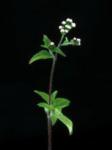Latin name
Ageratum conyzoides L.
Family
Asteraceae
Common name(s)
Tropical ageratum, goat weed
Synonym(s)
Ageratum hirsutum Poir., A. hirtum Lam., A. latifolium Cav., A. microcarpum (Benth.) Hemsl., Alomia microcarpa (Benth.) B. L. Rob., Carelia conyzoides (L.) Kuntze
Geographical distribution
Asia: China (including Hong Kong and Taiwan).
South and Southeast Asia: India, Indonesia, Lao PDR, Malaysia, Nepal, Philippines, Sri Lanka, Thailand, and Vietnam.
Rest of the world: Angola, Australia, Brazil, Cameroon, Colombia, Congo-Kinshasa, Costa Rica, Cote d'Ivoire, Cuba, Dominican Republic, Egypt, Ethiopia, Fiji, Ghana, Guinea, Hawaii, Kenya, Liberia, Mali, Mauritius, Melanesia, New Guinea, Nicaragua, Nigeria, Peru, Polynesia, Senegal, South Africa, Soviet Union, Suriname, Tanzania, Uganda, United States (including Hawaii), Venezuela, West Trinidad, and Zimbabwe.
Morphology
An annual, erect or decumbent, and somewhat aromatic herb.
Stem: erect, branched, and with rigid hairs; 30—20—cm—tall.
Leaf: ovate to deltoid with crenate margin, hairy, opposite, 5—13—cm—long, including the 3—50—mm petiole.
Inflorescence: dense terminal corymb with 8—15 heads white or very pale blue.
Fruit: a black achene; pappus of 5 awned scales.
Biology and ecology
Thrives in drier areas, in both heavy and light soils, although it prefers moist conditions. Flowers throughout the year.
A single plant may produce up to 40,000 seeds and half of these may readily germinate. Seed dispersal is mainly by wind and by water and these seeds can germinate in a wide range of environmental conditions.
Agricultural importance
A weed of pastures, plantation crops, sugarcane, cowpea, soybean, upland rice, and maize. It is a weed of chilies, upland rice, and peanuts in Sri Lanka, and of pineapple in Taiwan.
Reported as a host to several nematodes such as different Meloidogyne spp., also to fungi including Rhizoctonia solani and Sclerotium rolfsii, and to common cutworm Spodoptera litura.
Management
Cultural control: hand weeding at seedling stage commonly used to control this weed.
Chemical control: postemergence applications of 2,4-D at 0.5—0.8 kg/ha or MCPA at 0.4 kg/ha and butachlor or oxadiazon as preemergence treatment in upland rice provide effective control.
Selected references
Caton BP, Mortimer M, Hill JE. 2004. Weeds of rice in Asia. Los Baños (Philippines): International Rice Research Institute. 116 p.Galinato MI, Moody K, Piggin CM. 1999. Upland rice weeds of South and Southeast Asia. Los Baños (Philippines): International Rice Research Institute. 156 p.Holm L, Plucknett DL, Pancho JV, Herberger JP. 1977. The world's worst weeds: distribution and biology. Honolulu, Hawaii (USA): University Press of Hawaii. 609 p.Holm L, Pancho JV, Herberger JP, Plucknett DL. 1979. A geographical atlas of world weeds. New York (USA): John Wiley & Sons, Inc. 391 p.Ming LC. 1999. Ageratum conyzoides: a tropical source of medicinal and agricultural products. www.hort.purdue.edu.Moody K. 1989. Weeds reported in rice in South and Southeast Asia. Manila (Philippines): International Rice Reseach Institute. 442 p.Pancho JV, Obien SR. 1995. Manual of ricefield weeds in the Philippines. Munoz, Nueva Ecija (Philippines): Philippine Rice Research Institute. 543 p.Soerjani M, Kostermans AJGH, Tjitrosoepomo G. 1987. Weeds of rice in Indonesia. Jakarta (Indonesia): Balai Pustaka. 716 p.
Contributors
JLA Catindig, RT Lubigan, and DE Johnson
